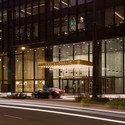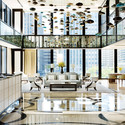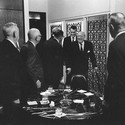In 2013, the former IBM building in Chicago last completed skyscrapers of Mies van der Rohe, has underwent a major renovation in the context of the tower was converted into a hotel. In this article, originally published in the Blueprint # 338 number as "Lobbying for Mies van der Rohe," Anthea Gerrie overtakes Dirk Lohan - Chicago architect who helped his grandfather design the building there are nearly 50 years, and has been called before to design the entrance of the new hotel lobby.
"It is not very Mies," says Dirk Lohan dubiously in one of the great understatements of the year. We are standing in the lobby of the hotel Langham Chicago with what looks like dozens of multicolored glass balls swimming above us and a glass mirrored frieze adding to a cacophony of glitter and glare Double height reception
Indeed, it is the antithesis of the aesthetic of the architect known for the phrase "less is more". But the daring idea of converting an office building by more functionalist architects in a five star hotel was always going to be problematic.



 12
12
"When the idea came, I was one of those who were skeptical," admits Lohan, who his own partisan point of view. as a small-son of Mies van der Rohe, it carries forward inheritance, if not quite to the point of avoiding the ornamentation in his own practice.
"This is my bling," he told a large, bronze beaded curtain, which brings understated glamor in the warm but discreet lobby below us. Here, Lohan was asked to form a bridge between hardliners windows from floor to ceiling, glass plate and the opulence of the hotel above. Lohan, who worked on the building with van der Rohe when he was ordered there has nearly 50 years by IBM, was recalled by the new owners to adapt the hall to its new use as a luxury home.
IBM must have had iconic building Seagram Mies in New York - has unveiled a decade earlier - in mind when he asked Mies to the color of its new regional headquarters in bronze. From the outside, but it is less spectacular monolith, due to specifications and site problems. The Chicago building is clad in brown anodized aluminum instead of real bronze, and the exciting sweep place is a landmark Mies is lost in the melee surrounding skyscrapers. The building itself, at the time of construction of the city the third highest, is now overshadowed by the giant tower Trump that sat next to in 08, depriving the IBM building most of his views of Lake Michigan .
The 52-storey building, Mies' last at the age of 80 and completed posthumously, is in his style typical skyscraper without compromise, while -to-ceiling glass floor separated by steel mullions at 1.5m intervals. But it was revolutionary at the time in his use of double glazing and other energy saving items. "He was really one of the first green office buildings," said Lohan, who arrived from Germany just in time to help his grandfather with the project. "The design vocabulary was already in place, but which was truly innovative was the technology. "
de many aspects of the design work well for a luxury hotel, he remarked: "the distance between the windows and the core - some 40ft [12m] - is a significant space really allows large hotel rooms of all sides of the building. " And travertine beloved Mies, who was picked up from the lobby and used extensively throughout the 13 stories that make up the hotel is a luxurious and functional finish.
While Lohan has designed several hotels itself - and also some just emblematic buildings in Chicago - he was only invited to design the lobby of the Langham, where his task was to differentiate space hotel of another hall, serving 75 percent of the building full of offices. "It's pretty rare," he nods toward a dispiritingly white shopping home in which only a couple of chairs Barcelona wink to the heritage of the building.
however, the Lohan hall, the first point of contact for customers before on receipt of the second floor is a warm and welcoming space furnished with sofas and chairs that Mies designed for his family, but never put into mass production. the seating area is headed by a striking bust by Jaume Plensa, making echoing a series on display outdoor display of sculpture in the city, Millennium Park.
Frankly, the 29m race Lohan bead curtain, a nod witty in the late sixty seems blingy enough, but apparently not for the owner, who demanded a stronger statement in the reception area of design practice Richmond International London, who worked on the very different, Neo Langham London. Principal Fiona Thompson admits it was a challenge imposing contemporary ideas on an iconic building of a more refined time back. The reception now has a cascade of multicolored glass pendants meant to evoke pebbles in the Chicago River, said Thompson, the one "art installation" that can not be permanent esteem.
"We estimated that it was necessary to refer to Chicago as well as the building, and also respect the owner's wishes, Grand Hong Kong Eagle, to create a luxury hotel that was not the middle of century modern or classic as the Langham London. "
She feels the frieze mirror glass facets around the back of the receipt is not in contradiction with the building, and stresses that the travertine and walnut ground lobby floor were practically all that remained of points within reference origin before it was gutted by companies of generations that have managed IBM. "So we used copiously, and also the real bronze some hardware stores, "she said.
Lohan admits his own sober style is less in harmony with the taste of Grand Aigle - "I am not opposed to colors or comfort, but I felt the interior design of the hotel should relate more to the architecture of Mies' - and believes his assistance was sought mainly to obtain a delicate modification of the outside past officials the Landmark Commission, where he is considered to have some influence. "A canopy was necessary to distinguish the entrance to the hotel so you can see the street," he says of the building, classified in 07, a year before the idea of a hotel was imagined by its previous owners.
Modification of a listed shell is always difficult, but the bronze canopy with starburst pin head lights is a elegant solution, certainly less vulgar than the letters of 6m high fixed outside the hotel opposite, spelling the name Trump. "And when your door is opposite to that huge building with its huge canopy, you must be at least a bit of a statement," says Lohan.
This stylish, most architects -pedigreed lives in another Chicago landmark of his grandfather - the penthouse in one of the few residential buildings of Mies: "860-880 Lake Shore Drive were the steel and glass towers original that started this whole movement, "enthuses Lohan, waving his hands to the ocean Miesian out there on the horizon, the monolithic steel and glass disciples paying homage to the master. Ironically, Mies chose not to live in his tour of residential strength, despite being given an apartment from the developer. "His excuse was that he did not take the elevator and be stuck listening to residents complain about their plumbing," says son-little dryly.
After half a century in the United States, Lohan, itself perfectly turned out in a beautifully tailored tweed jacket with a yellow silk handkerchief in the pocket, keeps a strong German accent - but he has done more than his grandfather to learn the language of his adopted country, "Mies resisted flee Nazi Germany when he was invited, years earlier because he did not speak English," he laughed.
Join the family business in 1962, Lohan also worked with Mies, from his new home in Chicago, the National Gallery in Berlin and New Dominion Centre in Toronto. He went on to design several important buildings in the second city, including a headquarters for another corporate giant, McDonald, and additions to the Shedd Aquarium and Adler Planetarium.
As orders goodbye to lavish reception he was not involved in, Lohan surprised with the kind diplomacy remark that distinguishes the policy of his grandfather - Mies was fiercely blunt with clients, simply ignoring those with whom he had creative differences. "Overall, I would give the hotel a very high rating," says Lohan. "Of course, it is sumptuous and there are too many mirrors, but the owner has spent money - it is quality and they must be given credit to assume the challenges of facing a historic building. ".
This article was published in the Blueprint # 338. Number To read more of Blueprint, visit DesignCurial.com
Posting Komentar